Winter 2019 CHE 6313: UNB Heating Plant Hydrogen Project Analysis
VerifiedAdded on 2023/01/13
|9
|1263
|65
Project
AI Summary
This project assesses the feasibility of converting the UNB heating plant from fossil fuels to hydrogen fuel, focusing on the economic and environmental benefits. The analysis highlights the current high CO2 emissions from the plant, primarily due to the use of wood, and the associated costs, including potential federal taxes on emissions. The report details the advantages of using a new hydrogen production technology, which promises significant cost reductions (up to 63%) compared to current operational expenses and traditional electrolysis methods. The study includes an economic analysis demonstrating substantial savings in operational costs and avoided CO2 emission taxes. The conclusion emphasizes the importance of implementing the new technology to reduce greenhouse gas emissions, improve profitability, and align with environmental regulations. The project includes data on fuel consumption, steam supply, and CO2 emissions over several years, supporting the analysis with charts and figures.
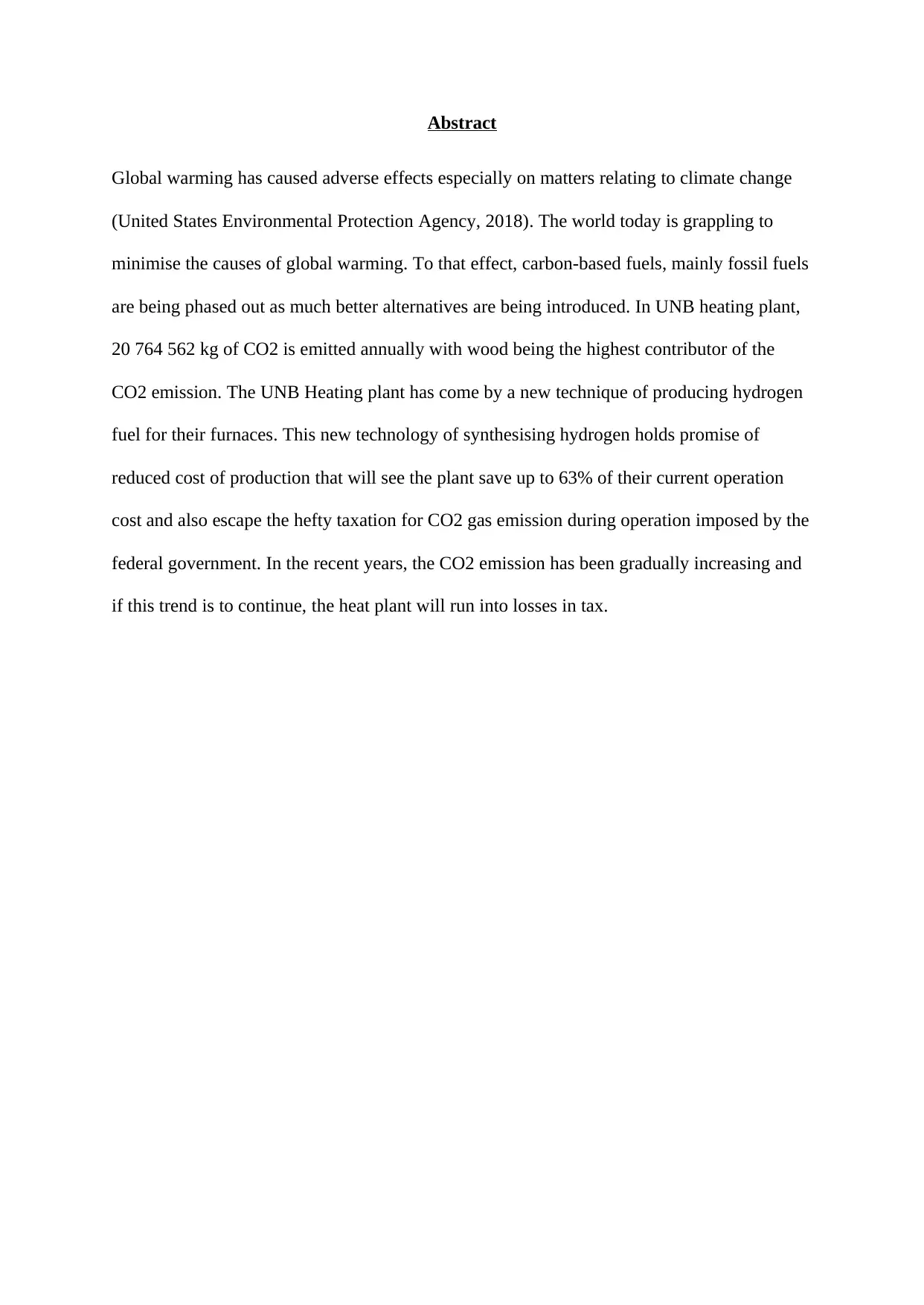
Abstract
Global warming has caused adverse effects especially on matters relating to climate change
(United States Environmental Protection Agency, 2018). The world today is grappling to
minimise the causes of global warming. To that effect, carbon-based fuels, mainly fossil fuels
are being phased out as much better alternatives are being introduced. In UNB heating plant,
20 764 562 kg of CO2 is emitted annually with wood being the highest contributor of the
CO2 emission. The UNB Heating plant has come by a new technique of producing hydrogen
fuel for their furnaces. This new technology of synthesising hydrogen holds promise of
reduced cost of production that will see the plant save up to 63% of their current operation
cost and also escape the hefty taxation for CO2 gas emission during operation imposed by the
federal government. In the recent years, the CO2 emission has been gradually increasing and
if this trend is to continue, the heat plant will run into losses in tax.
Global warming has caused adverse effects especially on matters relating to climate change
(United States Environmental Protection Agency, 2018). The world today is grappling to
minimise the causes of global warming. To that effect, carbon-based fuels, mainly fossil fuels
are being phased out as much better alternatives are being introduced. In UNB heating plant,
20 764 562 kg of CO2 is emitted annually with wood being the highest contributor of the
CO2 emission. The UNB Heating plant has come by a new technique of producing hydrogen
fuel for their furnaces. This new technology of synthesising hydrogen holds promise of
reduced cost of production that will see the plant save up to 63% of their current operation
cost and also escape the hefty taxation for CO2 gas emission during operation imposed by the
federal government. In the recent years, the CO2 emission has been gradually increasing and
if this trend is to continue, the heat plant will run into losses in tax.
Paraphrase This Document
Need a fresh take? Get an instant paraphrase of this document with our AI Paraphraser
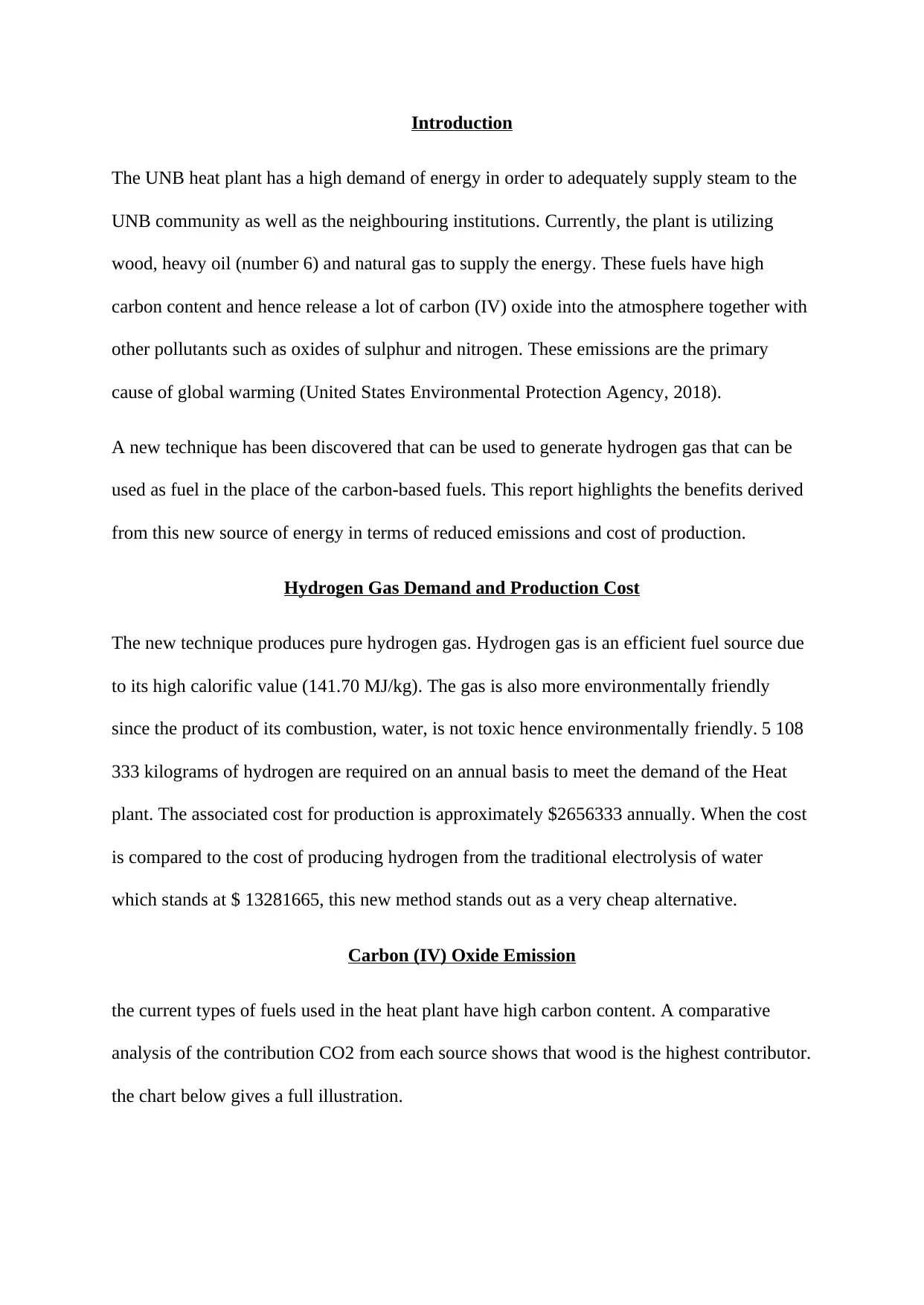
Introduction
The UNB heat plant has a high demand of energy in order to adequately supply steam to the
UNB community as well as the neighbouring institutions. Currently, the plant is utilizing
wood, heavy oil (number 6) and natural gas to supply the energy. These fuels have high
carbon content and hence release a lot of carbon (IV) oxide into the atmosphere together with
other pollutants such as oxides of sulphur and nitrogen. These emissions are the primary
cause of global warming (United States Environmental Protection Agency, 2018).
A new technique has been discovered that can be used to generate hydrogen gas that can be
used as fuel in the place of the carbon-based fuels. This report highlights the benefits derived
from this new source of energy in terms of reduced emissions and cost of production.
Hydrogen Gas Demand and Production Cost
The new technique produces pure hydrogen gas. Hydrogen gas is an efficient fuel source due
to its high calorific value (141.70 MJ/kg). The gas is also more environmentally friendly
since the product of its combustion, water, is not toxic hence environmentally friendly. 5 108
333 kilograms of hydrogen are required on an annual basis to meet the demand of the Heat
plant. The associated cost for production is approximately $2656333 annually. When the cost
is compared to the cost of producing hydrogen from the traditional electrolysis of water
which stands at $ 13281665, this new method stands out as a very cheap alternative.
Carbon (IV) Oxide Emission
the current types of fuels used in the heat plant have high carbon content. A comparative
analysis of the contribution CO2 from each source shows that wood is the highest contributor.
the chart below gives a full illustration.
The UNB heat plant has a high demand of energy in order to adequately supply steam to the
UNB community as well as the neighbouring institutions. Currently, the plant is utilizing
wood, heavy oil (number 6) and natural gas to supply the energy. These fuels have high
carbon content and hence release a lot of carbon (IV) oxide into the atmosphere together with
other pollutants such as oxides of sulphur and nitrogen. These emissions are the primary
cause of global warming (United States Environmental Protection Agency, 2018).
A new technique has been discovered that can be used to generate hydrogen gas that can be
used as fuel in the place of the carbon-based fuels. This report highlights the benefits derived
from this new source of energy in terms of reduced emissions and cost of production.
Hydrogen Gas Demand and Production Cost
The new technique produces pure hydrogen gas. Hydrogen gas is an efficient fuel source due
to its high calorific value (141.70 MJ/kg). The gas is also more environmentally friendly
since the product of its combustion, water, is not toxic hence environmentally friendly. 5 108
333 kilograms of hydrogen are required on an annual basis to meet the demand of the Heat
plant. The associated cost for production is approximately $2656333 annually. When the cost
is compared to the cost of producing hydrogen from the traditional electrolysis of water
which stands at $ 13281665, this new method stands out as a very cheap alternative.
Carbon (IV) Oxide Emission
the current types of fuels used in the heat plant have high carbon content. A comparative
analysis of the contribution CO2 from each source shows that wood is the highest contributor.
the chart below gives a full illustration.
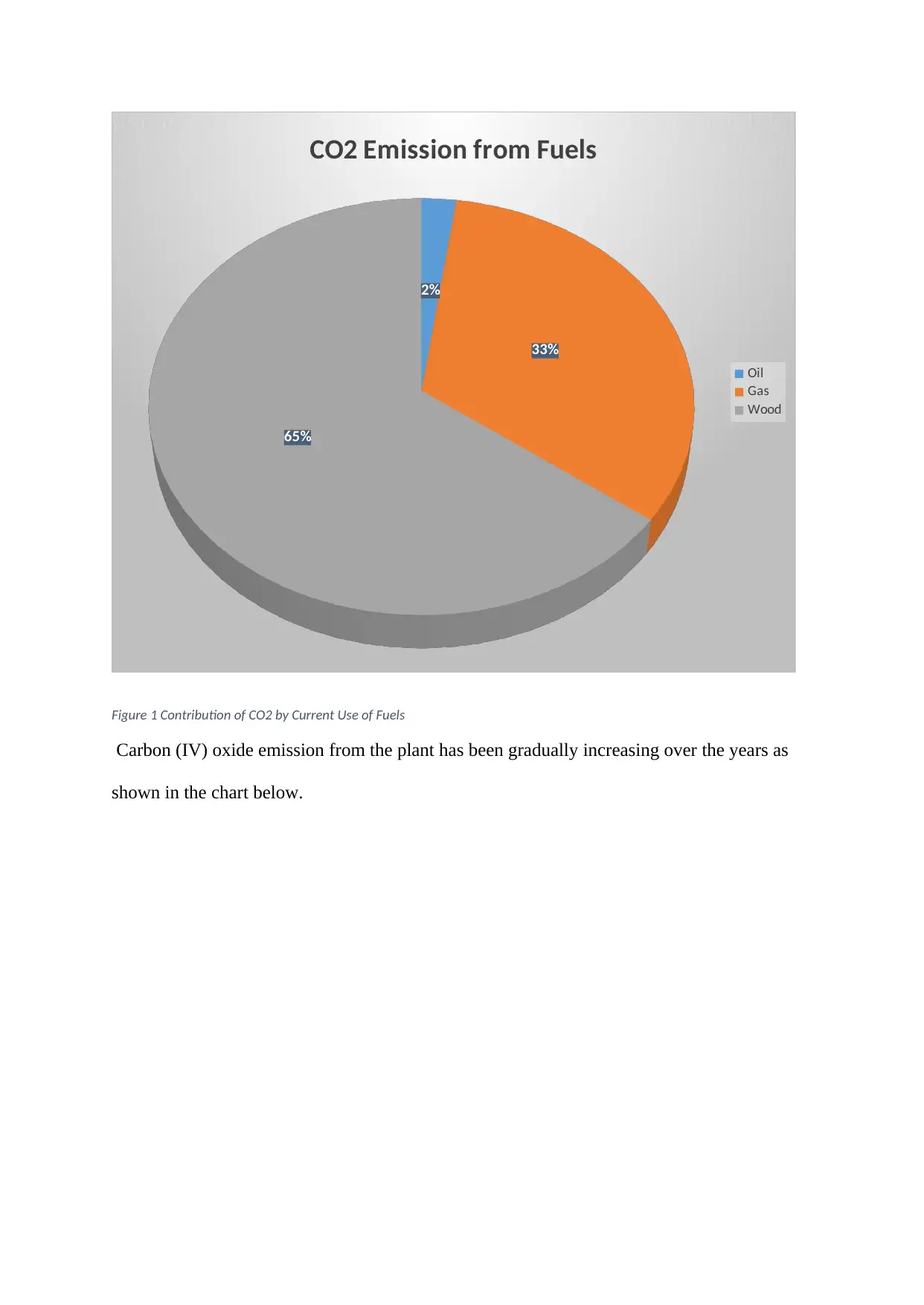
2%
33%
65%
CO2 Emission from Fuels
Oil
Gas
Wood
Figure 1 Contribution of CO2 by Current Use of Fuels
Carbon (IV) oxide emission from the plant has been gradually increasing over the years as
shown in the chart below.
33%
65%
CO2 Emission from Fuels
Oil
Gas
Wood
Figure 1 Contribution of CO2 by Current Use of Fuels
Carbon (IV) oxide emission from the plant has been gradually increasing over the years as
shown in the chart below.
⊘ This is a preview!⊘
Do you want full access?
Subscribe today to unlock all pages.

Trusted by 1+ million students worldwide
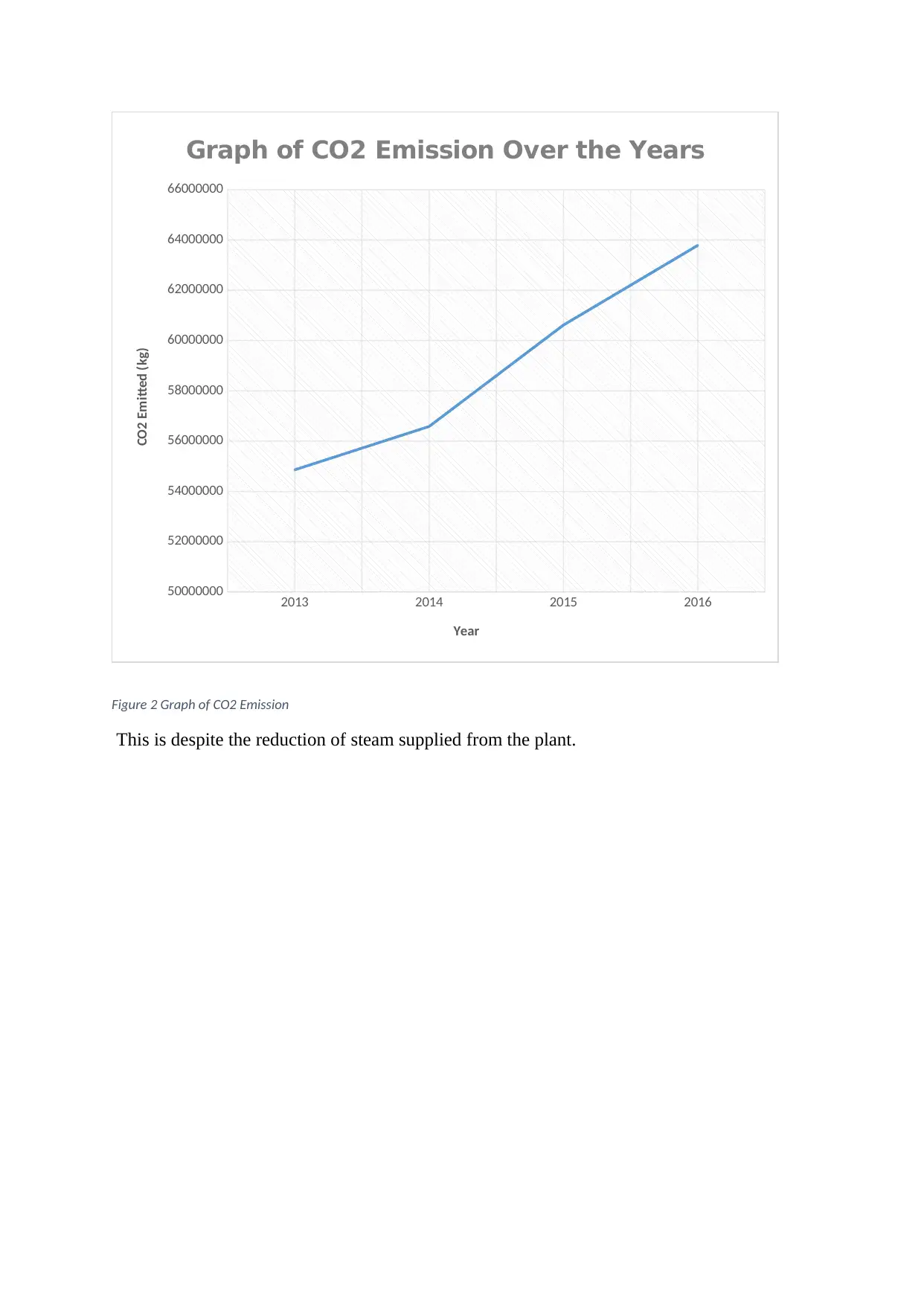
2013 2014 2015 2016
50000000
52000000
54000000
56000000
58000000
60000000
62000000
64000000
66000000
Graph of CO2 Emission Over the Years
Year
CO2 Emitted (kg)
Figure 2 Graph of CO2 Emission
This is despite the reduction of steam supplied from the plant.
50000000
52000000
54000000
56000000
58000000
60000000
62000000
64000000
66000000
Graph of CO2 Emission Over the Years
Year
CO2 Emitted (kg)
Figure 2 Graph of CO2 Emission
This is despite the reduction of steam supplied from the plant.
Paraphrase This Document
Need a fresh take? Get an instant paraphrase of this document with our AI Paraphraser

2013 2014 2015 2016
94000000
96000000
98000000
100000000
102000000
104000000
106000000
108000000
110000000
112000000
Steam Supplied
year
Quantity of Steam (lb)
Figure 3 Steam Supplied Over the Years
The rise in emissions is attributed to the increase in the use of wood as a source of fuel while
the use of natural gas decreases as shown on the chart below.
94000000
96000000
98000000
100000000
102000000
104000000
106000000
108000000
110000000
112000000
Steam Supplied
year
Quantity of Steam (lb)
Figure 3 Steam Supplied Over the Years
The rise in emissions is attributed to the increase in the use of wood as a source of fuel while
the use of natural gas decreases as shown on the chart below.
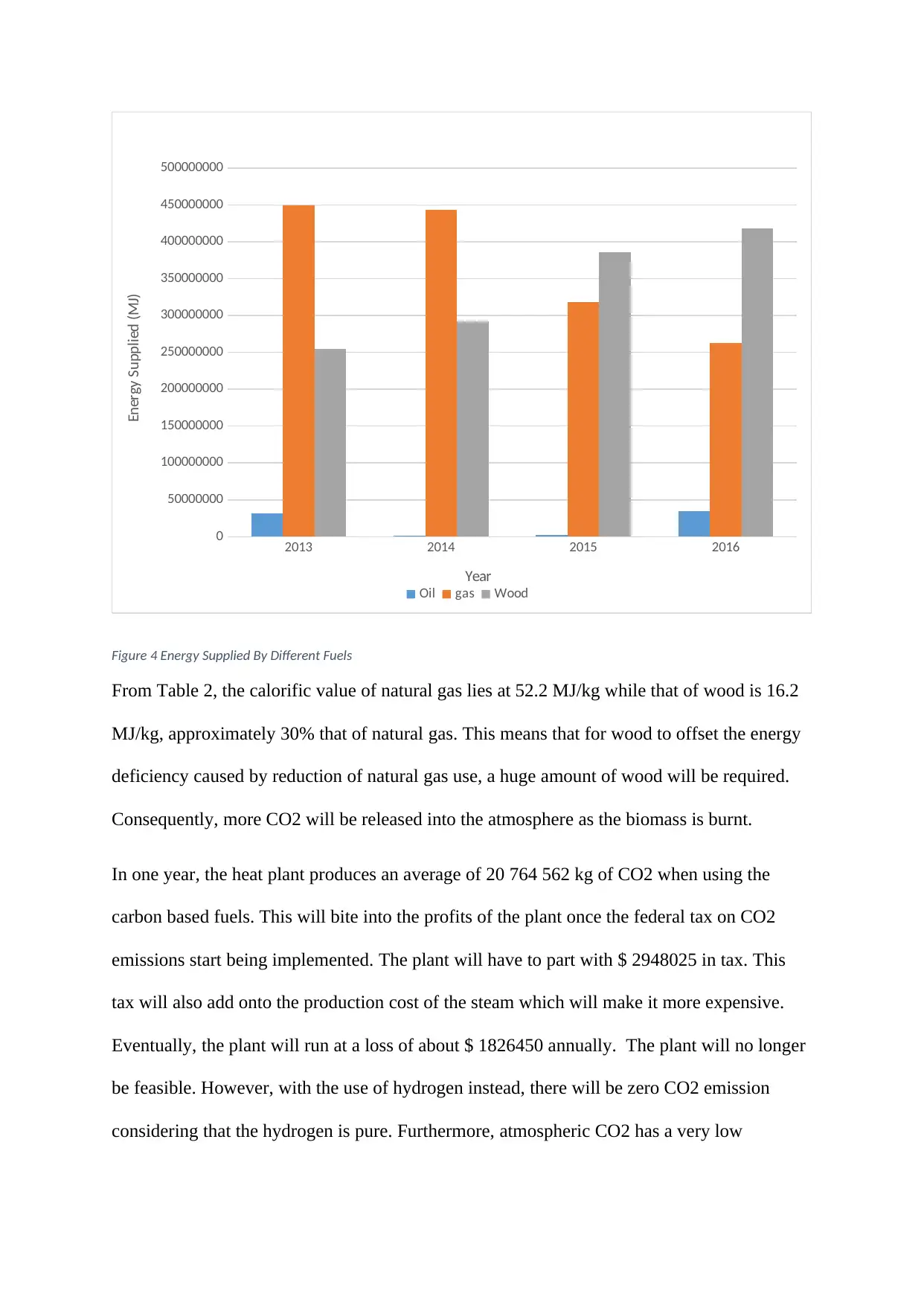
2013 2014 2015 2016
0
50000000
100000000
150000000
200000000
250000000
300000000
350000000
400000000
450000000
500000000
Oil gas Wood
Year
Energy Supplied (MJ)
Figure 4 Energy Supplied By Different Fuels
From Table 2, the calorific value of natural gas lies at 52.2 MJ/kg while that of wood is 16.2
MJ/kg, approximately 30% that of natural gas. This means that for wood to offset the energy
deficiency caused by reduction of natural gas use, a huge amount of wood will be required.
Consequently, more CO2 will be released into the atmosphere as the biomass is burnt.
In one year, the heat plant produces an average of 20 764 562 kg of CO2 when using the
carbon based fuels. This will bite into the profits of the plant once the federal tax on CO2
emissions start being implemented. The plant will have to part with $ 2948025 in tax. This
tax will also add onto the production cost of the steam which will make it more expensive.
Eventually, the plant will run at a loss of about $ 1826450 annually. The plant will no longer
be feasible. However, with the use of hydrogen instead, there will be zero CO2 emission
considering that the hydrogen is pure. Furthermore, atmospheric CO2 has a very low
0
50000000
100000000
150000000
200000000
250000000
300000000
350000000
400000000
450000000
500000000
Oil gas Wood
Year
Energy Supplied (MJ)
Figure 4 Energy Supplied By Different Fuels
From Table 2, the calorific value of natural gas lies at 52.2 MJ/kg while that of wood is 16.2
MJ/kg, approximately 30% that of natural gas. This means that for wood to offset the energy
deficiency caused by reduction of natural gas use, a huge amount of wood will be required.
Consequently, more CO2 will be released into the atmosphere as the biomass is burnt.
In one year, the heat plant produces an average of 20 764 562 kg of CO2 when using the
carbon based fuels. This will bite into the profits of the plant once the federal tax on CO2
emissions start being implemented. The plant will have to part with $ 2948025 in tax. This
tax will also add onto the production cost of the steam which will make it more expensive.
Eventually, the plant will run at a loss of about $ 1826450 annually. The plant will no longer
be feasible. However, with the use of hydrogen instead, there will be zero CO2 emission
considering that the hydrogen is pure. Furthermore, atmospheric CO2 has a very low
⊘ This is a preview!⊘
Do you want full access?
Subscribe today to unlock all pages.

Trusted by 1+ million students worldwide
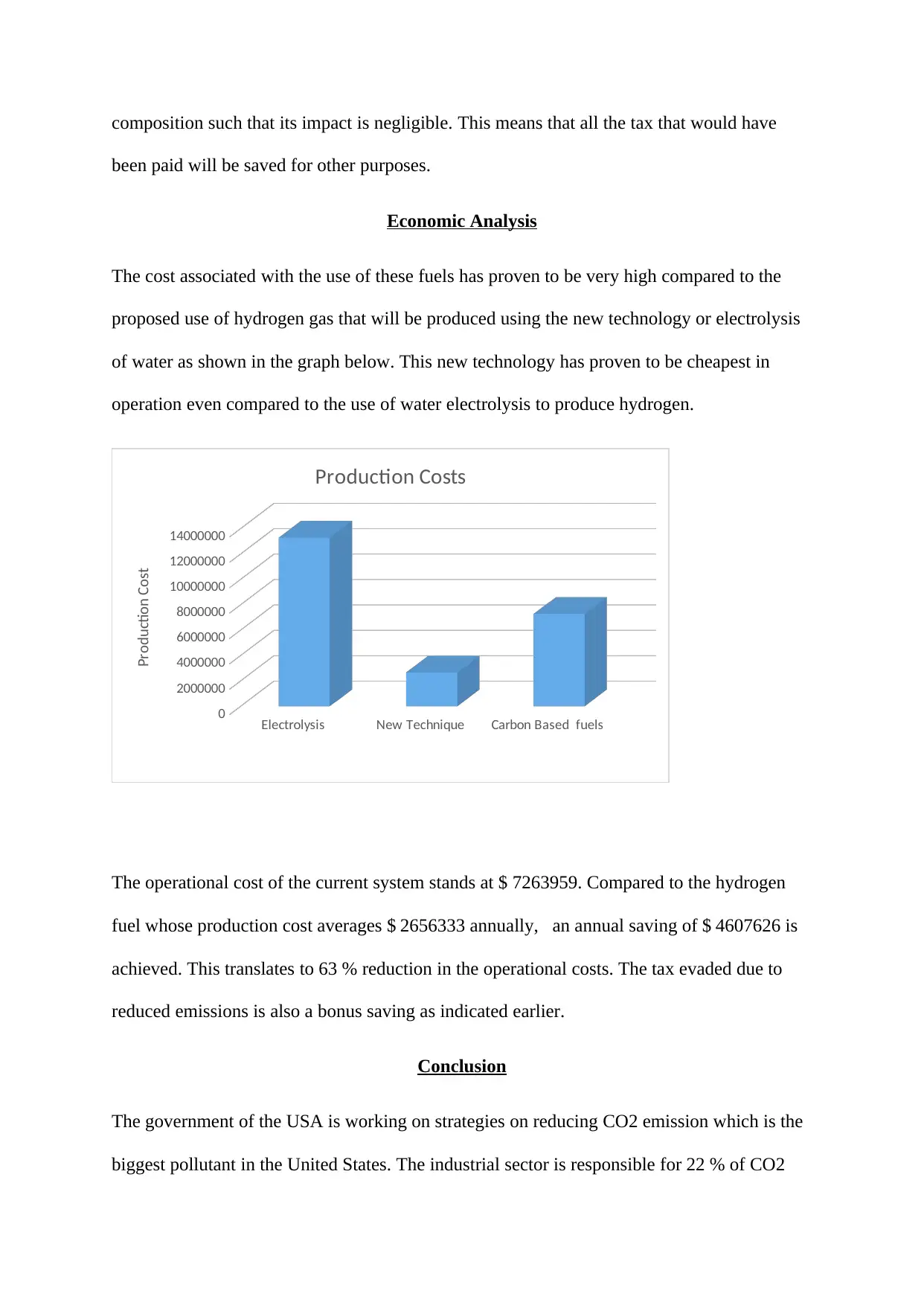
composition such that its impact is negligible. This means that all the tax that would have
been paid will be saved for other purposes.
Economic Analysis
The cost associated with the use of these fuels has proven to be very high compared to the
proposed use of hydrogen gas that will be produced using the new technology or electrolysis
of water as shown in the graph below. This new technology has proven to be cheapest in
operation even compared to the use of water electrolysis to produce hydrogen.
Electrolysis New Technique Carbon Based fuels
0
2000000
4000000
6000000
8000000
10000000
12000000
14000000
Production Costs
Production Cost
The operational cost of the current system stands at $ 7263959. Compared to the hydrogen
fuel whose production cost averages $ 2656333 annually, an annual saving of $ 4607626 is
achieved. This translates to 63 % reduction in the operational costs. The tax evaded due to
reduced emissions is also a bonus saving as indicated earlier.
Conclusion
The government of the USA is working on strategies on reducing CO2 emission which is the
biggest pollutant in the United States. The industrial sector is responsible for 22 % of CO2
been paid will be saved for other purposes.
Economic Analysis
The cost associated with the use of these fuels has proven to be very high compared to the
proposed use of hydrogen gas that will be produced using the new technology or electrolysis
of water as shown in the graph below. This new technology has proven to be cheapest in
operation even compared to the use of water electrolysis to produce hydrogen.
Electrolysis New Technique Carbon Based fuels
0
2000000
4000000
6000000
8000000
10000000
12000000
14000000
Production Costs
Production Cost
The operational cost of the current system stands at $ 7263959. Compared to the hydrogen
fuel whose production cost averages $ 2656333 annually, an annual saving of $ 4607626 is
achieved. This translates to 63 % reduction in the operational costs. The tax evaded due to
reduced emissions is also a bonus saving as indicated earlier.
Conclusion
The government of the USA is working on strategies on reducing CO2 emission which is the
biggest pollutant in the United States. The industrial sector is responsible for 22 % of CO2
Paraphrase This Document
Need a fresh take? Get an instant paraphrase of this document with our AI Paraphraser

emission (United States Environmental Protection Agency, 2018). The government has come
up with the taxation on CO2 emissions for industries in order to reduce harmful CO2
produced by industries and reduce the rate at which these gases cause environmental and
health problems. The taxation will ensure that manufacturers put in place proper corrective
mechanisms to control emissions as well as come up with alternative fuel sources (Centre for
Climate and Energy Solutions, n.d.).
UNB should implement the new hydrogen generation technology as soon as possible for the
institution to benefit from its high profit gains and save the environment from greenhouse
gases.
up with the taxation on CO2 emissions for industries in order to reduce harmful CO2
produced by industries and reduce the rate at which these gases cause environmental and
health problems. The taxation will ensure that manufacturers put in place proper corrective
mechanisms to control emissions as well as come up with alternative fuel sources (Centre for
Climate and Energy Solutions, n.d.).
UNB should implement the new hydrogen generation technology as soon as possible for the
institution to benefit from its high profit gains and save the environment from greenhouse
gases.

References
Centre for Climate and Energy Solutions. (n.d.). Policy Hub>> Carbon Pricing. Retrieved
from Centre for Climate and Energy Solutions: https://www.c2es.org/content/carbon-tax-
basics/
United States Environmental Protection Agency. (2018, October 9). Greenhouse Emissions:
Sources of Greenhouse Gas Emissions. Retrieved from United States Environmental
Protection Agency: https://www.epa.gov/ghgemissions/sources-greenhouse-gas-emissions
Centre for Climate and Energy Solutions. (n.d.). Policy Hub>> Carbon Pricing. Retrieved
from Centre for Climate and Energy Solutions: https://www.c2es.org/content/carbon-tax-
basics/
United States Environmental Protection Agency. (2018, October 9). Greenhouse Emissions:
Sources of Greenhouse Gas Emissions. Retrieved from United States Environmental
Protection Agency: https://www.epa.gov/ghgemissions/sources-greenhouse-gas-emissions
⊘ This is a preview!⊘
Do you want full access?
Subscribe today to unlock all pages.

Trusted by 1+ million students worldwide
1 out of 9
Related Documents
Your All-in-One AI-Powered Toolkit for Academic Success.
+13062052269
info@desklib.com
Available 24*7 on WhatsApp / Email
![[object Object]](/_next/static/media/star-bottom.7253800d.svg)
Unlock your academic potential
Copyright © 2020–2025 A2Z Services. All Rights Reserved. Developed and managed by ZUCOL.





